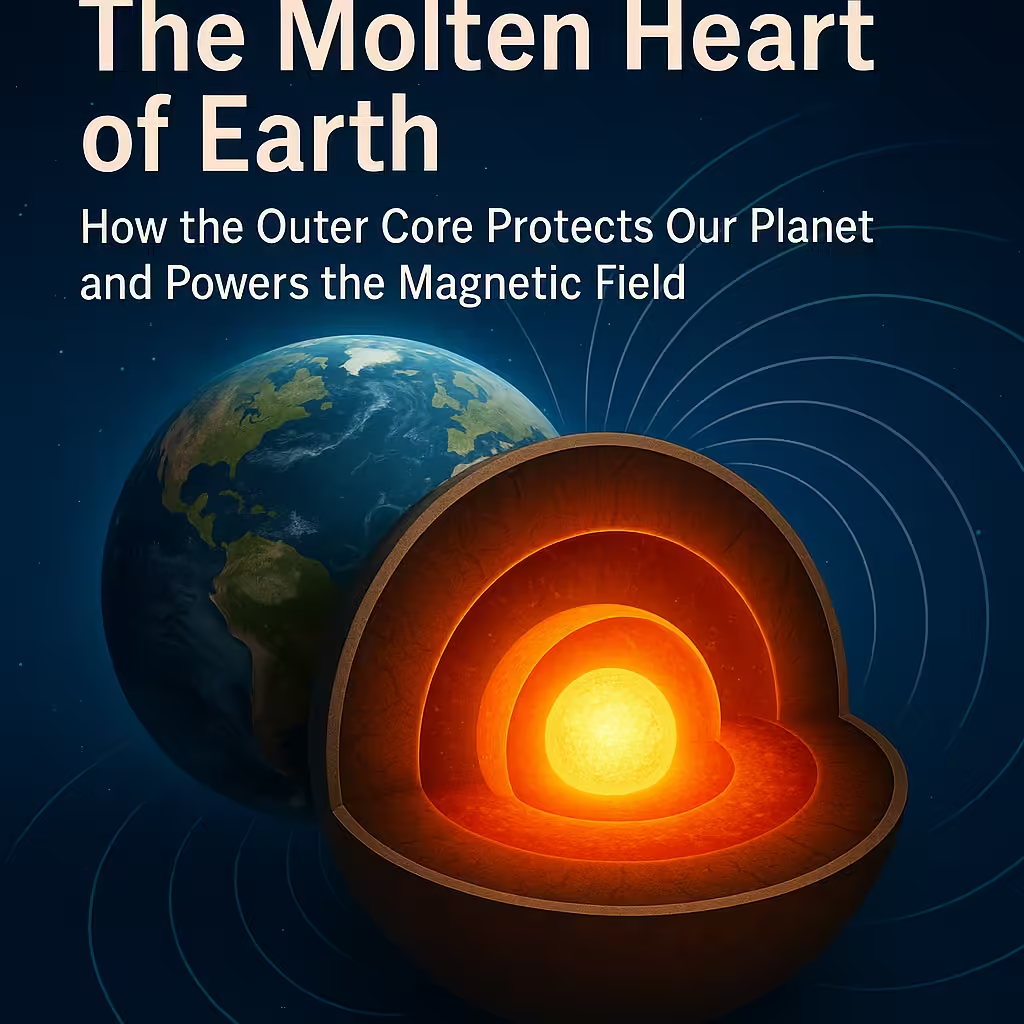
Birds, Quantum Entanglement, and the Mysterious Science of Migration
The Molten Heart of Earth: How the Outer Core Protects Our Planet and Powers the Magnetic Field
Beneath our feet, beyond the crust and the shifting plates that form continents and ocean floors, lies one of Earth’s most remarkable features—its outer core. Invisible to the naked eye and unreachable by any drill ever built, this swirling ocean of molten iron plays a silent yet pivotal role in sustaining life on our planet. It is not just a geological layer; it is the beating heart of Earth’s magnetic shield—a shield that keeps the solar wind at bay and allows life to thrive on the surface.
The Secret Beneath the Surface
To truly appreciate the importance of the Earth’s outer core, it helps to imagine peeling the planet like an onion. First, you pass through the rocky crust—thin and brittle in geological terms. Beneath that lies the mantle, a semi-solid region of flowing rock that extends nearly 2,900 kilometers down. But it is what lies beneath the mantle that is truly awe-inspiring: the outer core, a vast, churning sea of molten metal, primarily iron mixed with some nickel and lighter elements.
Unlike the solid inner core that rests beneath it—about the size of the Moon—the outer core remains in a liquid state due to extreme heat. Temperatures in this layer range from 4,000°C to 6,000°C, rivaling the surface of the Sun. Under such conditions, iron flows freely like water, in massive convection currents powered by heat escaping from the inner core and the cooling of the planet over geological time.
Earth’s Giant Dynamo
This movement is not random; it’s structured and dynamic. As the molten iron flows, it generates electric currents. According to the principles of electromagnetism, moving conductive materials (like molten iron) can produce magnetic fields. This process is known as the geodynamo—Earth’s self-sustaining magnetic engine.
It’s similar to how a dynamo on a bicycle works: the motion of the wheel turns coils within a magnetic field, producing electricity to power a light. On a planetary scale, however, the process is reversed. Here, the motion of conducting material creates electricity, and that electric current creates a magnetic field.
The result? Earth’s magnetic field—a massive, invisible force field stretching tens of thousands of kilometers into space. Without this natural protective barrier, Earth would be bombarded relentlessly by charged particles from the Sun, known as the solar wind.
Why the Magnetic Field Matters
The Sun emits a steady stream of high-energy particles, mostly electrons and protons, which travel outward at speeds of hundreds of kilometers per second. When these particles reach Earth, they slam into the magnetic field and are deflected around the planet like a river splitting around a rock.
This protective role is vital. Without the magnetic field, solar wind would strip away the atmosphere over millions of years, eroding the very conditions that make life possible. In fact, scientists believe this is what happened to Mars. Although Mars may have once had a magnetic field and a thicker atmosphere, the loss of its core dynamo left it vulnerable to the Sun’s radiation. Today, the Red Planet is a cold, dry desert with a thin, barely-there atmosphere—an example of what could have happened to Earth.
Beyond protecting the atmosphere, the magnetic field also plays an essential role in shielding our technology. Satellites, GPS systems, power grids, and even airplane communications would all be far more vulnerable to geomagnetic storms caused by solar activity if it weren’t for this invisible armor.
A Dynamic and Mysterious Force
Earth’s magnetic field is not static. It constantly shifts, changes strength, and even flips polarity over geologic timescales. In fact, the North and South magnetic poles have reversed many times in Earth’s history—a process known as geomagnetic reversal. During these transitions, the magnetic field weakens, sometimes to a fraction of its original strength, before gradually re-establishing itself in the opposite direction.
These flips do not happen overnight; they unfold over thousands of years. While they’re not catastrophic in themselves, they do raise questions about how well life and technology would fare under a weakened shield. It’s a reminder that our planet’s internal engine is not just a stable backdrop—it’s a living, evolving system.
The Aurora: A Glimpse of the Core’s Power
One of the most breathtaking demonstrations of Earth’s magnetic shield is the aurora borealis (Northern Lights) and aurora australis (Southern Lights). These spectacular displays of color occur when solar wind particles penetrate the upper atmosphere near the poles and interact with oxygen and nitrogen atoms.
Though they appear serene and magical, auroras are in fact evidence of the ongoing battle between solar radiation and Earth’s protective shield. Without the outer core creating this defense mechanism, there would be no auroras—nor a safe surface on which to stand and admire them.
Probing the Inaccessible
Despite its crucial role, the outer core remains one of Earth’s least accessible realms. No human instrument has ever reached it directly. Instead, scientists rely on seismic data—waves generated by earthquakes that travel through the planet. By analyzing how these waves change speed or get refracted at various depths, researchers can infer the existence, state, and composition of Earth’s inner layers.
These seismic studies revealed that while S-waves (which only move through solids) cannot pass through the outer core, P-waves (which move through both solids and liquids) do. This is how we know that the outer core is liquid and the inner core is solid. It’s a fascinating detective story told through tremors and time.
The Core of Life
It’s humbling to realize that the fate of everything we know—oceans, weather, animals, technology, and human civilization—depends on a turbulent sea of molten iron more than 2,000 kilometers beneath our feet. The outer core is our planet’s unsung hero, working tirelessly to generate a field that shields, stabilizes, and sustains Earth.
We live our lives on a thin crust, rarely giving thought to the planetary furnace below. Yet it’s this very heart of Earth that enables us to exist. It’s easy to take it for granted, but when we pause to consider the deep and dynamic processes below the surface, we uncover a remarkable truth: Earth is not just a rock floating in space. It’s a self-regulating system—a planet with a heartbeat.
Conclusion
From creating the magnetic field that makes compasses work, to fending off solar storms that could fry our electronics, the Earth’s outer core is more than a geological curiosity. It is a dynamic, life-saving engine spinning ceaselessly beneath our feet. While unseen, it is deeply felt in every breath of atmosphere we enjoy and every beam of sunshine that isn’t filtered by solar death rays. Next time you look up at a glowing aurora or navigate with a compass, remember—it all begins in the heart of our planet.

